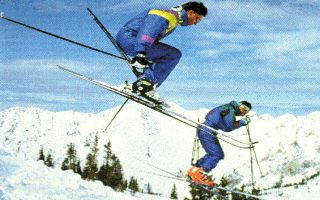CADS!

Ski with the Legs of Half your Age
Dallas Morning News
see the recent article:
Bad Knees? This device might let you keep skiing
For other ski topics, try Ski Central
SKIING Reviews CADS STRUT YOUR STUFF CADS, those rods attached to boot and back, can help you ski better. By Nicholas Howe Reprinted in its entirety with permission Skiing with CADS is skiing with questions. People sometimes hesitate, wondering if it
would be rude to ask. Then they ask. For me, the questions began last winter, with my
first day on CADS at Vail, and continued after I’d gotten home to New Hampshire. Q: What are those things on your legs? A: They’re called CADS, which is the easy way of
saying Constant–force Articulated Dynamic Struts. Q: They look weird. What do they do? A: CADS work like a car’s front–end
suspension, which lifts the car’s body, presses the tires against the road, and
stabilizes the geometry of the steering system. Q: Yeah, but don’t they feel strange? A: At first they felt very strange: as if my
body were being lifted, my skis were being pressed down on the snow, and my legs were in
strange: as if my body were being lifted, my skis were being pressed down on the snow, and
my legs were in zero–g. Now the only strange part comes when the afternoon ends and
my legs feel as if it were still morning. Q: Are they hard to get used to? A: Don’t jump right onto black diamond bumps.
Start with skating on a smooth beginner slope, then make GS turns on a steeper slope, then
go to crud to get confident. Q: They look dangerous. Won’t the rod poke you if you fall? A: I can’t imagine that happening, partly because
of the way the rods are mounted, and partly because I can’t imagine how I’d fall
with CADS. Like many skiers, I used to be a conditions–ninny: When heavy crud or
boilerplate came along, I’d back off, I’d get in trouble, I’d be miserable,
and I’d quit. That’s all gone now. With CADS, I just keep sailing along. As an Easterner, I also got burning thighs and out of breath the first few days on
Colorado trips. The first time I tried CADS was at the 11,250–foot top of Vail. Ten
inches of overnight snow had turned to lumpy spring crud, and I expected to pull up after
five turns, pant, and wait for the fire in my thighs to go out. In stead, I made nonstop
turns all the way down to Mid–Vail, then began talking without so much as a single
deep breath. By this time the interlocutor is getting used to the look of my CADS. A webbing
strap goes around each thigh, with a cord from each strap passing over a little pulley at
the top of a slender fiberglass rod and down to a thick rubber band anchored in a swivel
at the back of each boot, which also sockets the lower end of the rod. The cords usually
run out through neat brass grommets set into your pants just below the waist, but I’m
still wearing the web rigging on the outside. For lifts or lunch, a flick of the wrist
disengages the rods, which store inside a pair of ski poles that comes with each set of
CADS. Q: Who thought of all this? A: Take the next lift ride with me for a more extended
essay on the picturesque etiology of CADS. One day Walter Dandy was riding up a lift at Heavenly Valley and noticed how much his
thighs hurt after a run in the heavy Sierra snow. Suddenly, like Paul’s revelation on
the way to Damascus, Walter saw the CADS design in his mind’s eye, unannounced by any
prior thought, but complete in every detail. This surprise probably had two origins. For one thing, there’s invention in
Walter’s blood. Hi family counts a long line of important innovators in many fields:
19th–century harbor dredges and industrial milling machines, break–through
neurosurgery—one family member even invented the batter’s helmet, but
didn’t patent it because he thought one shouldn’t make money from sports. For
another thing, Walter is quite severely afflicted with dyslexia, the perceptual disorder
that usually makes it difficult to make sense of printed words but can also lead to
startling originality in conceptual design. Walter spent several years working on his idea, but he realized he didn’t have the
skills he’d need for development and production. So he looked in the Yellow Pages and
found Tony Nespor, Czech by birth, now an engineer in Walter’s native Baltimore and a
fountain of technical skills. The market launch, however, was not easy. Trying to sell the
first CADS, Walter says, was like trying to sell the first oyster. Now Walter has the eager evangelical nature of a man who has repealed a troublesome law
of nature. He also has a large pile of letters that read like testimonials from pilgrims
to the curative shrine at Lourdes: people with arthritic knees and hips, with bad backs,
with circulation problems, with legs weakened by age or debilitating disease, with knees
torn by too great a devotion to risks of all kinds. Also from people like me, who just
thought they’d give CADS a try. After several days in Vail, I came back home to New Hampshire and Wildcat and more
questions. Q: Do those things work in every kind of snow? A: Sure, and some places that are hardly even snow. I
just hit an alligator, and it didn’t bother me at all. Q: An alligator? A: Yeah, one of those places where a grooming tractor
went down a slushy slope and the track froze solid with all the knobs and ridges hard as
granite. It was chatter city, instant disaster in my former life, but with CADS I made
turns the whole length of it and never so much as scraped an edge. Not only that, but I started the day at Wildcat with two nonstop runs, which I
couldn’t have done on the best day I ever had as a rubber–legged teenager. My
first days of using CADS were all dizzy infatuation, but now I’m settling down to
steadier thought and I notice that CADS seem to have a built–in pedagogy. I’ve
always tended to sit back too much, now I’m moving forward to the position all those
instruction articles recommend. I’m also looking farther down the hill, another
instruction favorite. Q: Don’t your skis do odd things with that rigging attached
to your boots? A: Yes, they do the right things, which
doesn’t necessarily happen when it’s only me that’s attached to them. This
is because, in an Aristotelian sense, a ski wants to do the right thing, it has
good behavior designed into it. That is, when a ski is flat, it goes straight; when
it’s on edge, it turns. My skis only get in trouble because I make mistakes and they
can’t get away from me. Q: Huh? A: Sure. It’s pressure that makes a ski work
properly, and losing that pressure or misapplying it is what gets you in trouble, like
chattering. When a ski chatters in a turn, when it bounces on a rough surface, each bounce
causes the ski to lose contact with the snow and breaks the arc of the edge that is making
the ski turn. You can understand this better if you think about fleas. Q: I am, but it doesn't help. A: Okay, look at it this way: If a flea went skiing,
it wouldn’t have trouble with chattering. That’s because fleas can store energy
in their legs, which is why they can jump hundreds of times their own height. We
can’t store energy in our legs, but the rubber spring on CADS can. Practically
everything we do on skis involves dropping down from a straight–legged positions, and
when we wear CADS, quite a lot of the weight we lower is stored as energy and used to
press the skis on the snow. Q: So the more I lower my weight, the more I flex my knees, the
more pressure goes into my skis? A: Good question! That was a big problem for
Walter and Tony Nespor and the answer is the C, the Constant–force part of the name.
We have a lot of energy storage devices in everyday life—torsion bars, leaf springs,
coil springs, slingshots, archers’ bows—and so on, but none of those are
constant–force. When you load most springs, it starts easy and gets harder;
that’s nonlinear force, what engineers call stacking. The release is stacked, too:
first a lot, then less and less. What was needed for CADS was a nonstacking spring, a
nearly constant–force spring. Walter and Tony tried all kinds of metal springs but there were too complicated and
bulky, so they went back to basic chemistry and developed a rubber spring with the
characteristics they needed. That means the pressure on your ski stays almost constant
whether you’ve got a little flex in your knees or a lot. Q: What about breaking? My slingshots always broke on the really
big jobs. A: Walter and Tony thought about that: What would cold
and ultraviolet light do to the rubber? So they went back to high–tech engineering
and hung one of their first rubber springs on a backyard fence. It’s still perfectly
good after four years. All of this means that CADS provide a steady downward force that keeps the skis from
doing bad things, like chattering and getting deflected by bumps or crud, and at the same
time CADS help skis do all the good things that are built into their design. And if that
isn’t enough happiness, your knees and legs are bearing less weight, so your knees
don’t get hurt and your muscles don’t get tired. Q: Ah–hah! I knew it sounded too good to be
true! If CADS are taking the weight off my legs, that means my quads are turning into
noodles. A: I can tell you’ve been reading those T–shirts that read No pain, no
gain. But they don’t have it quite right. A burning thigh muscle is an anaerobic
thigh muscle, it’s overdrawn its oxygen account at the metabolic bank. You can
gain strength with anaerobic exercise, the heavy, grunting, painful kind favored by weight
lifters and sprinters who need those quick explosive moves. But you can also gain strength
by staying in the aerobic mode, by keeping your muscles well–supplied with oxygen
while they’re working. Your legs will gain strength by having a good long aerobic
workout without thigh burn. Q: Well, what about purity? I mean, CADS look like a pretty
artificial deal. We’ve got enough high–tech stuff in this world already. Skiing
is my chance to get natural. A: I know what you mean, but purity has its slippery
slopes, too. Does a zillion dollars worth of snow guns and grooming tractors give you
natural skiing? And what about equipment? When I started skiing, my boots were about like
what I’d wear for work shoes now and my skis were solid ash with toe–strap
bindings and no metal edges. Heck, the equipment we use now costs more than a new car
cost then, and it’s probably more highly engineered. Have I lost virtue because
I’m using modern equipment? Maybe so, but I’m also having a lot more fun now.
The rest is up to the theologians.
![]()
Have a question for us? Call us: 970-949-4533
email: cads@colorado.net
or snail mail: 2121 N. Frontage Road, PMB 160, Vail, CO
81657

